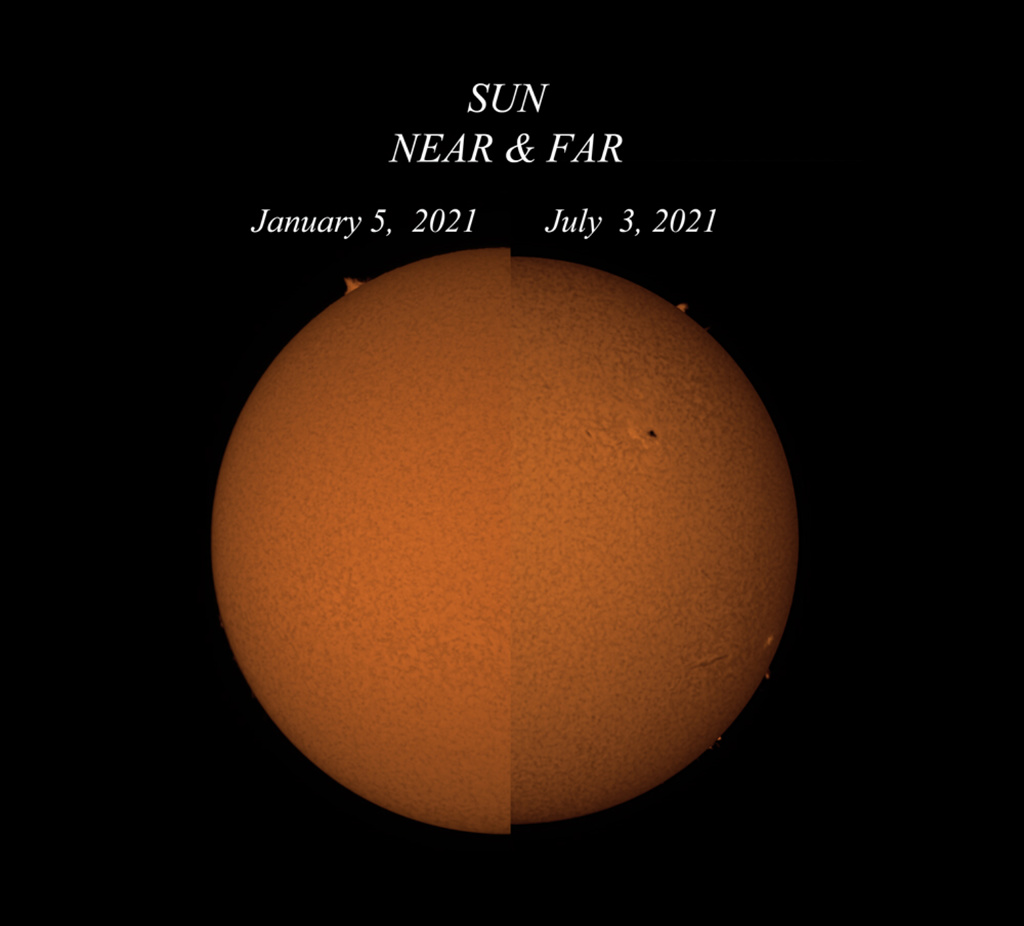08. July 2021
Ùi 近日點 kàu 遠日點

探索宇宙1!逐工會揀一幅無仝款 ê 影像抑是相片,𤆬你熟似咱這个迷人 ê 宇宙,閣有專業天文學者2為你3解說4。
- 原始文章:Perihelion to Aphelion
- 影像來源 kah 版權:[Richard Jaworski](mailto:rich [email protected])
- 台文翻譯:An-Li Tsai (NCU)
[漢羅] Ùi 近日點 kàu 遠日點
2021 年 ê 遠日點 發生 tī 7 月 5 號。 彼是地球長株圓軌道面頂,離太陽上遠彼點。 是講,地球 kah 太陽 ê 距離毋是用來決定季節 ê。 季節是 ùi 地球自轉軸 ê 趨度 決定 ê,所以 7 月 tī 北半球猶是熱天,tī 南半球猶是寒天。 毋閣 7 月 5 號這工 ê 太陽,確實 ùi 地球來看是上細粒 ê。 這張組合相片是 kā 兩張用仝一支望遠鏡 kah kha-mé-lah 翕 ê 太陽相片綴予齊齊。 倒爿彼半張是 tī 2017 年,欲到近日點(1 月 2 號)彼陣翕 ê。 近日點 to̍h 是地球軌道面頂,離太陽上近彼點。 正爿彼半張是拄仔好 tī 遠日點進前翕 ê。 太陽 tī 近日點 kah 遠日點 ê 視直徑變化,比 3 葩閣較加淡薄仔。 若無這張相片,to̍h 會較歹注意著。
[POJ] Ùi kīn-ji̍t-tiám kàu oán-ji̍t-tiám
Jī-khòng-jī-it nî ê oán-ji̍t-tiám hoat-seng tī chhit goe̍h gō͘ hō. He sī Tē-kiû tn̂g-tu-îⁿ kúi-tō bīn-téng, lî Thài-iông siōng-hn̄g hit tiám. Sī-kóng, Tē-kiû kah Thài-iông ê kū-lî m̄-sī iōng-lâi koat-tēng kùi-chiat ê. Kùi-chiat sī ùi Tē-kiû chū-choán-te̍k ê chhu-tō͘ koat-tēng ê, só͘-í chhit goe̍h tī pak-pòaⁿ-kiû iáu-sī joa̍h-thiⁿ, tī lâm-pòaⁿ-kiû iáu-sī kôaⁿ-thiⁿ. M̄-koh chhit goe̍h gō͘ hō chit-kang ê Thài-iông, khak-si̍t ùi Tē-kiû lâi-khòaⁿ sī siōng sè-lia̍p ê. Chit-tiuⁿ cho͘-ha̍p siòng-phìⁿ sī kā nn̄g-tiuⁿ iōng kâng chi̍t-ki bōng-oán-kiàⁿ kah kha-mé-lah hip--ê Thài-iông-siòng-phìⁿ tòe hō͘ chiâu-chê. Tò-pêng hit pòaⁿ-tiuⁿ sī tī jī-khòng-it-chhit nî, beh kàu kīn-ji̍t-tiám (it goe̍h jī hō) hit-chūn hip--ê. Kīn-ji̍t-tiám to̍h sī Tē-kiû kúi-tō bīn-téng, lî Thài-iông siōng-kng hit-tiám. Chiàⁿ-pêng hit pòaⁿ-tiuⁿ sī tú-á-hó tī oán-ji̍t-tiám chìn-chêng hip--ê. Thài-iông tī kīn-ji̍t-tiám kah oán-ji̍t-tiám ê sī-ti̍t-kèng piàn-hòa, pí saⁿ-pha koh-khah ke--tām-po̍h-á. Nā-bô chit-tiuⁿ siòng-phìⁿ, to̍h ē khah-phái chù-ì--tio̍h.
[KIP] Uì kīn-ji̍t-tiám kàu uán-ji̍t-tiám
Jī-khòng-jī-it nî ê uán-ji̍t-tiám huat-sing tī tshit gue̍h gōo hō. He sī Tē-kiû tn̂g-tu-înn kuí-tō bīn-tíng, lî Thài-iông siōng-hn̄g hit tiám. Sī-kóng, Tē-kiû kah Thài-iông ê kū-lî m̄-sī iōng-lâi kuat-tīng kuì-tsiat ê. Kuì-tsiat sī uì Tē-kiû tsū-tsuán-ti̍k ê tshu-tōo kuat-tīng ê, sóo-í tshit gue̍h tī pak-puànn-kiû iáu-sī jua̍h-thinn, tī lâm-puànn-kîu iáu-sī kuânn-thinn. M̄-koh tshit gue̍h gōo hō tsit-kang ê Thài-iông, khak-si̍t uì Tē-kiû lâi-khuànn sī siōng sè-lia̍p ê. Tsit-tiunn tsoo-ha̍p siòng-phìnn sī kā nn̄g-tiunn iōng kâng tsi̍t-ki bōng-uán-kiànn kah kha-mé-lah hip--ê Thài-iông-siòng-phìnn tuè hōo tsiâu-tsê. Tò-pîng hit puànn-tiunn sī tī jī-khòng-it-tshit nî, beh kàu kīn-ji̍t-tiám (it gue̍h jī hō) hit-tsūn hip--ê. Kīn-ji̍t-tiám to̍h sī Tē-kiû kuí-tō bīn-tíng, lî Thài-iông siōng-kng hit-tiám. Tsiànn-pîng hit puànn-tiunn sī tú-á-hó tī uán-ji̍t-tiám tsìn-tsîng hip--ê. Thài-iông tī kīn-ji̍t-tiám kah uán-ji̍t-tiám ê sī-ti̍t-kìng piàn-huà, pí sann-pha koh-khah ke--tām-po̍h-á. Nā-bô tsit-tiunn siòng-phìnn, to̍h ē khah-phái tsù-ì--tio̍h.
[English] Perihelion to Aphelion
Aphelion for 2021 occurred on July 5th. That's the point in Earth's elliptical orbit when it is farthest from the Sun. Of course, the distance from the Sun doesn't determine the seasons. Those are governed by the tilt of Earth's axis of rotation, so July is still summer in the north and winter in the southern hemisphere. But it does mean that on July 5 the Sun was at its smallest apparent size when viewed from planet Earth. This composite neatly compares two pictures of the Sun, both taken with the same telescope and camera. The left half was captured close to the date of the 2021 perihelion (January 2), the closest point in Earth's orbit. The right was recorded just before the aphelion in 2021. Otherwise difficult to notice, the change in the Sun's apparent diameter between perihelion and aphelion amounts to a little over 3 percent.
詞彙學習
| 漢羅 | POJ | KIP | 華語 | English |
|---|---|---|---|---|
| 近日點 | kīn-ji̍t-tiám | kīn-ji̍t-tiám | 近日點 | perihelion |
| 遠日點 | oán-ji̍t-tiám | uán-ji̍t-tiám | 遠日點 | aphelion |
| 長株圓軌道 | tn̂g-tu-îⁿ kúi-tō | tn̂g-tu-înn kúi-tō | 橢圓形軌道 | elliptical orbit |
| 自轉軸 | chū-choán-te̍k | tsū-tsuán-ti̍k | 自轉軸 | axis of rotation |
| 趨度 | chhu-tō͘ | tshu-tōo | 斜度 | tilt |
| 北半球 | pak-pòaⁿ-kiû | pak-puànn-kiû | 北半球 | north hemisphere |
| 南半球 | lâm-pòaⁿ-kiû | lâm-puànn-kiû | 南半球 | southern hemisphere |
| 視直徑 | sī-ti̍t-kèng | sī-ti̍t-kìng | 視直徑 | apparent diameter |